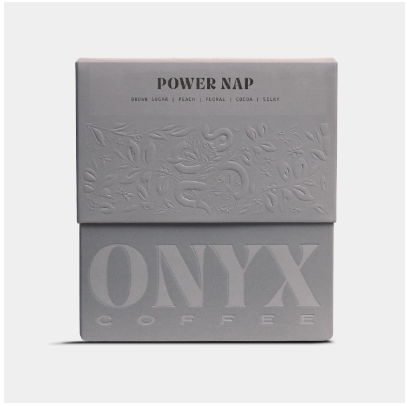
About this Coffee
OK, so you need a quick burst of energy, but your bedtime is in three hours. You, my friend, need a POWER NAP. You already love our floral washed Worka from Ethiopia. Well, we blended it with a natural sugar cane process Colombia creating Power Nap. We created this “half-caf” blend just for you, a pre-roast blend of 50% of our beloved Ethiopia Worka and 50% of our Decaf Colombia Huila. The resulting cup is silky sweet and reminiscent of ripe peach and cocoa, with a sweet finish of brown sugar. It’s so tasty; you might just have two cups and stay up past your bedtime.
HALF-CAF
There’s a perfect point in a nap where you wake up feeling refreshed and energized. Power naps are short and to the point, hitting the zone where you get the benefits of sleep without the grogginess. This coffee is like a power nap. You get the uplifting benefits of a nap without having to hang a do not disturb sign on your office door. It’s a half-caffeinated coffee, a 50/50 blend of our sugar cane-process decaffeinated Colombia Huila, and our washed Ethiopia Worka. We blend this coffee prior to roasting, to achieve a uniform taste profile to make the highest possibility of a true half-caf coffee.
Often a cafe’s half-caf coffees are an unwieldy blend of two different coffees, limiting your chances for a pleasant extraction. We roasted Power Nap to be both delicious on filter and espresso, with the best chance of getting a half-caffeine cup of coffee. Gone are the awkward half-caf shots, or limiting your afternoon coffee to a half cup. The only thing that you need to feel awkward about is how sweet and pleasant this coffee tastes.
ETHIOPIA WORKA
This coffee’s journey began in an unlikely place: Minnesota. Negusse Debela visited a specialty coffee cafe and had a revelation over how diverse and sweet a cup of coffee can be. From this moment, Negusse began to explore coffee back home in the Yirgacheffe region of Ethiopia. He experienced the tradition of growing and processing coffee and understood how to improve and move coffee forward in his home. From this journey, SNAP specialty coffee was established in 2008, aiming to supply high-end specialty coffee, facilitating a similar experience that Neguesse had in Minnesota years ago.
From its wet mill in Gedeb, SNAP works with 486 smallholder producers to produce complex and floral coffees that are outstanding examples of what Yirgacheffe coffees can be. SNAP operates in Gedeb with its vertically integrated Veer Trading Company. The work that is put into processing these coffees is upheld by their dry mill in Addis Ababa. After each harvest, these coffees are sorted by screen size, as well as density. This focus on processing and milling produces extremely stable and delicious coffee each season.
DECAF COLOMBIA HUILA
This is another excellent decaf coffee from Cafe Imports. Frequently we need a beautiful spot lot of decaf, and this one fits what we were looking for. Last season we visited Popayán, Colombia, and had the pleasure of cupping with Banexport, one of their export partners. The team at Banexport is extremely organized in their cupping protocol, cupping though thousands of micro-lots through each harvest. Coffees are chosen to build regional green coffee blends, of which some are decaffeinated. The idea of making regional blends is to highlight the predominant profile of coffees of that region, creating a sort of archetype profile. Huila regularly produces award-winning coffees, and the department’s general taste profile is known to be balanced and sweet, with dynamic acidity. The outcome of this blend is a coffee that upholds the sweetness and texture of coffee from Huila that we love, but without the caffeine.
EA DECAFFEINATION
Sugar cane ethyl acetate or commonly known as EA decaf is a natural process of decaffeinating coffee. It is usually found in Colombia where sugar cane is readily available and starts with making molasses from sugar cane. Once created, it sits in vats to ferment. The bacteria produce acetic acid, much like fermenting coffee, and at the peak of fermentation, alcohol is added to make something called ethyl acetate.
For it to be applied to coffee first, the green coffee is steamed in tanks to elevate the moisture level — the beans swell, which allows the extraction of caffeine. Ethyl acetate is added to the mixture, and it dissolves the caffeine in the coffee. The coffee is then washed with water and laid to dry. In theory, the coffee should reach the same moisture content as it arrived in, which is somewhere between 11-12%. The most important part of EA coffee, and why it tastes so sweet, is it avoids high pressure and high heat, which degrades coffee quickly. This allows the natural terroir flavors to come through, making it a sweet and bright decaf.